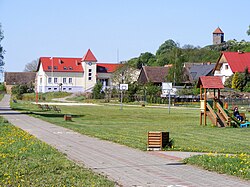Santok
This article has multiple issues.Please helpimprove itor discuss these issues on thetalk page.(Learn how and when to remove these messages)
|
Santok | |
|---|---|
Village | |
 Town Hall and watchtower | |
| Coordinates:52°44′N15°25′E/ 52.733°N 15.417°E | |
| Country | |
| Voivodeship | |
| County | Gorzów |
| Gmina | Santok |
| Area | 168.3 km2(65.0 sq mi) |
| Population (2006) | 780 |
| • Density | 4.6/km2(12/sq mi) |
| Time zone | UTC+1(CET) |
| • Summer (DST) | UTC+2(CEST) |
| Postal Code | 66-431 |
| Area Code | (+48) 95 |
| Vehicle registration | FGW |
| Voivodeship roads | |
| Website | www |
Santok[ˈsantɔk](German:Zantoch) is avillageinGorzów County,Lubusz Voivodeship,in western Poland. It is the seat of thegmina(administrative district) calledGmina Santok.[1]
Geography
[edit]Santok is located at the confluence of theNotećandWartarivers, approximately 12 km (7 mi) east ofGorzów Wielkopolski.
Contemporary Santok is a large villagestreet,over 3 km (2 mi) long. The village is situated at the mouth ofNotećtoWarta,on a narrow terrace Pradolina Toruńsko-Eberswaldzka. From the south it is limited by theWartaandNotećbeds, and from the north by the high edge of the Gorzowska Plain.
On the left bank of theWarta,settlements have been preserved, which are now a small wooded hill among wet meadows. Originally, they were located in the fork ofWartaandNoteć,but during a catastrophic flood in 1751,Wartachanged its channel, and decided to create a new one to the north of the settlement. Archaeological research confirmed the existence of 12 settlement layers in this area, dating from the8thto14thcenturies.[2]
History
[edit]A first fortified settlement at the site was founded in the late 7th century. Santok is mentioned in the 12th century as "barbican and key" (Latin:clavem et terris custodiam) to thePolish kingdomat the border with theDuchy of Pomeraniain theGesta principum Polonorumchronicle byGallus Anonymus.

Re-established byBolesław I the Bravein the days of the medievalPiast dynasty,Santok became an important border fortress ofGreater Polandand seat of acastellany.An attack by DukeBarnim I of Pomeraniain 1251 was repelled. During the 13th century however, the strategically importanthill fortbecame the object of claims raised by theAscanianmargraves ofBrandenburg,who intended to enlarge their territories in theNeumarkregion east of theOderriver. Upon the marriage of MargraveConrad of Brandenburg-StendalwithConstance,daughter of the deceased DukePrzemysł I of Greater Poland,in 1260, Santok passed to the margraviate as part of her dowry. Once again reconquered by the Polish dukePrzemysł II,it finally was incorporated by Brandenburg upon his death in 1296.
The Polish kingCasimir III the Greattemporarily recaptured Santok from 1365; still after his death in 1370, the title of acastellanwas awarded by the Polish monarchs until the late 18th century. Within the BrandenburgNeumarkregion, the fortress lost its importance in favour of nearby Landsberg (Gorzów Wielkopolski). In 1402, an agreement was reached between Poland and the Luxembourgs, according to which Poland was to buy and re-incorporate Santok and the surrounding region,[3]but eventually the Luxembourgs sold it to theTeutonic Order.It was devastated byHussitetroops in the course of thePolish–Teutonic Warin 1433.
In the 18th century, Santok consisted of two ownership shares. One part belonged to the property complex ofFrederick Henry, Margrave of Brandenburg-Schwedtand the remainder was owned by the Schöning noble family. During theSeven Years' War,Santok was plundered and destroyed by Russian troops in 1758.
From 1815, the town belonged to the district of Landsberg inRegierungsbezirk Frankfurtof theProvince of BrandenburginPrussiaand since 1871 alsoGermany.Towards the end ofWorld War II,it was occupied by theRed Armyon January 20, 1945. Shortly thereafter, with the implementation of theOder-Neisse line,Santok became again part of Poland, as part of the extensiveterritorial changes of Poland after World War II.In the following years, theGermanpopulation was expelled in accordance with thePotsdam Agreement.
References
[edit]- ^"Central Statistical Office (GUS) - TERYT (National Register of Territorial Land Apportionment Journal)"(in Polish). 2008-06-01.
- ^Rospond, Stanisław (1984).Etymological dictionary of cities and communes of the People's Republic of Poland.Wrocław: Ossolineum. pp. 341–342.ISBN83-04-01090-9.
- ^Rogalski, Leon (1846).Dzieje Krzyżaków oraz ich stosunki z Polską, Litwą i Prussami, poprzedzone rysem dziejów wojen krzyżowych. Tom II(in Polish). Warszawa. pp. 59–60.


